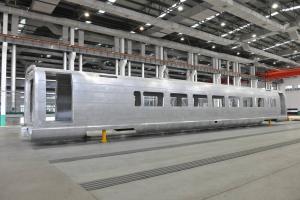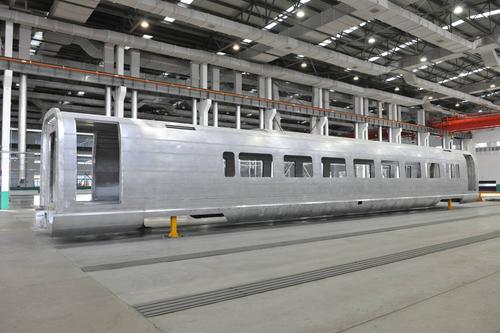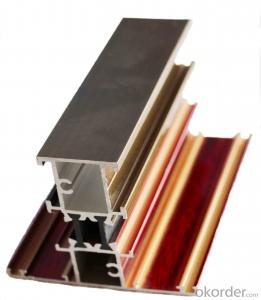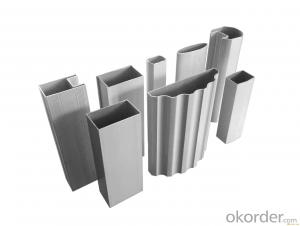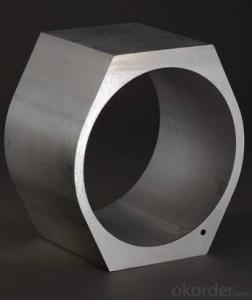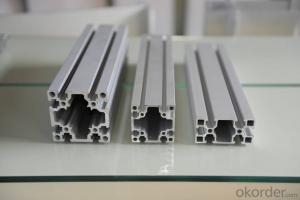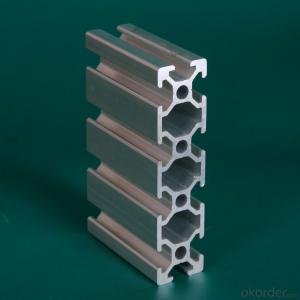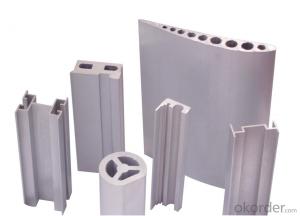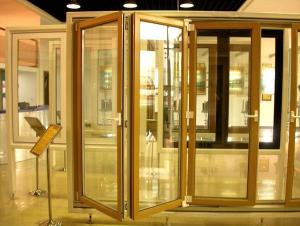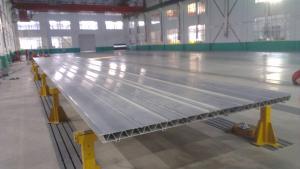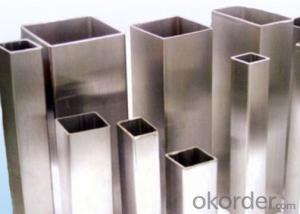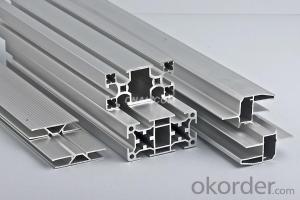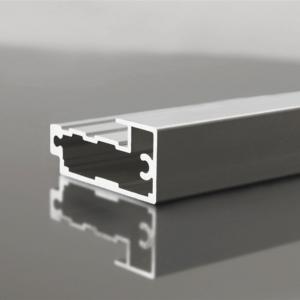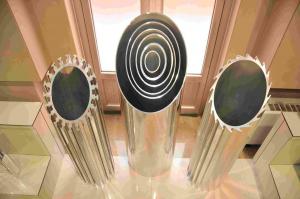Aluminum Extruded Profiles for Truck Bodies
- Loading Port:
- China Main Port
- Payment Terms:
- TT OR LC
- Min Order Qty:
- -
- Supply Capability:
- -
OKorder Service Pledge
OKorder Financial Service
You Might Also Like
Aluminium truck body made of extruded profiles
1. Usage:High-speed railway and Metro
2. Surface: Mill finish or anodized as customer’s requirement
3. Alloy: alloy temper 6005A, 6101, 6061,etc.
4. Standard: EN755
5. Lead time: shortest delivery time
6. OEM/ODM is available
7. Advantage:
Tolerance applied by international standard
Low energy consumption, low gas emission,
high speed, environmental friendliness
Product Name | Aluminum profile for subway body |
Size | As customers’ requirements |
Material | 6061 6005 7020 7005 7003 7A09 |
Temper | T5 T6 etc. |
Standard | GB /ASTM |
Surface Treatment | Anodized/powder coating |
Colour | Mill finish |
Application | Transportation,Jambo,Machine, Equipment |
Origin | China |
Port | Shanghai |
MOQ | 5 Tons |
Delivery Time | 90 work days after deposit or original L/C |
Payment Terms | T/T, L/C |
Supply Ability | 5000Tons / Month |
Packaging | Export standard packing |
- Q: This question asks for methods to prevent moisture from entering aluminum profiles during the installation process.
- <p>To prevent moisture from getting into aluminum profiles during installation, ensure proper sealing and insulation. Use high-quality weatherstripping and sealants around joints and connections. Install moisture barriers or vapor retarders where necessary, especially in areas prone to high humidity. Keep profiles dry during handling and storage, and avoid installing in wet conditions. Regularly inspect and maintain the profiles to identify and address any potential moisture issues early.</p>
- Q: What are the different types of surface protection for aluminum profiles?
- There are several different types of surface protection options available for aluminum profiles. These options are designed to enhance the durability and aesthetics of the aluminum profiles and provide protection against various environmental factors. 1. Anodizing: Anodizing is one of the most common methods of surface protection for aluminum profiles. It involves creating a protective oxide layer on the surface of the aluminum through an electrochemical process. Anodizing provides excellent corrosion resistance and can be done in various colors. 2. Powder Coating: Powder coating involves applying a dry powder to the surface of the aluminum profiles, which is then cured under heat to form a protective layer. Powder coating offers a wide range of color options, excellent durability, and resistance to scratching, chipping, and fading. 3. Paint: Painting is another option for surface protection of aluminum profiles. It involves applying a liquid paint coating to the surface, which provides both protection and aesthetic enhancement. Paint can be customized in terms of color, texture, and finish, but it may not be as durable as other options. 4. Clear Coating: Clear coating is a transparent protective layer that can be applied to aluminum profiles. It provides a glossy finish while preserving the natural appearance of the aluminum. Clear coating offers protection against corrosion, UV radiation, and other environmental factors. 5. Cladding: Cladding involves covering the aluminum profiles with another material, such as stainless steel or composite panels. This provides additional protection against corrosion and wear, while also adding aesthetic appeal and design versatility. 6. Film/Protective Tape: Applying a temporary film or protective tape to the surface of aluminum profiles can provide short-term protection during transportation, installation, or construction. These films or tapes can be easily removed after use, leaving the aluminum profile intact. Each of these surface protection options has its own advantages and disadvantages, and the choice depends on the specific requirements of the application, desired aesthetics, budget, and expected environmental conditions.
- Q: What is the HS code for aluminum profile?
- Plenty more......76041010 non alloy aluminum bars and rods76041090 non alloy aluminum profiles and profiles76042100 Aluminum Alloy air core profile76042910.109999999 column solid aluminum alloy76042910.189999998 column solid aluminum alloy76042910.909999996 other aluminium alloy bars and rods (section, Zhou Changda)76042910.989999995 other aluminum alloy bars and rods (small section perimeter)76042990 other aluminum alloy profiles, profiles76051100 non alloy aluminum wire with maximum cross sectional size > 7mmNon alloy aluminum wire 76051900 maximum cross-sectional dimension less than or equal to 7mm76052100 aluminum alloy wire with maximum cross sectional size > 7mm76052900 the maximum cross-sectional dimension less than 7mm aluminum alloy wire76061120 non alloy aluminum rectangular plates, sheets and strips (includingRectangular sheets, sheets and strips of aluminium alloy 76061220A rectangular plate, sheet, and band of aluminium alloy 7606123076061250 0.35mm< less than 4mm thickness for a rectangular Aluminum Alloy76061290 thickness >4mm aluminium alloy rectangular thick plate,76069100 non alloy aluminum non rectangular plates, plates and stripsNon rectangular plates, sheets, and strips of aluminium alloy 76069200Without the backing of aluminium foil 76071110 after rolling without further processingWithout the backing of aluminium foil 76071120 after rolling without further processingWithout the backing of aluminium foil 76071190 after rolling without further processing76071900.900000006 other non aluminum foil backing
- Q: Are aluminum profiles suitable for earthquake-resistant structures?
- Yes, aluminum profiles can be suitable for earthquake-resistant structures. Aluminum is lightweight and flexible, allowing it to absorb and dissipate the energy generated during an earthquake. Additionally, aluminum profiles have excellent strength-to-weight ratio and corrosion resistance, making them a suitable choice for seismic applications. However, the design and engineering of the structure, along with appropriate reinforcement, are crucial factors in ensuring its earthquake resistance.
- Q: Are aluminum profiles recyclable multiple times? If yes, explain the process.
- <p>Yes, aluminum profiles can be recycled multiple times. The recycling process for aluminum involves melting the scrap aluminum, which requires only 5% of the energy needed to produce new aluminum from raw materials. After collection, aluminum profiles are sorted, cleaned, and shredded into small pieces. These pieces are then melted in a furnace and cast into new ingots or billets. From there, they can be rolled, extruded, or forged into new aluminum products. This cycle can be repeated indefinitely without loss of quality, making aluminum one of the most sustainable materials.</p>
- Q: Are aluminum profiles suitable for furniture applications?
- Indeed, furniture applications can benefit from the use of aluminum profiles. Aluminum, known for its versatility and lightweight nature, offers numerous advantages in furniture design and construction. To begin with, aluminum profiles boast exceptional strength and durability, making them the perfect fit for furniture that endures regular use and bears weight. Moreover, their resistance to corrosion allows for their usage both indoors and outdoors, without the worry of rusting or deterioration over time. Furthermore, aluminum profiles provide design flexibility. They can be effortlessly molded and shaped into various forms and sizes, allowing for the creation of innovative and unique furniture designs. Additionally, aluminum profiles can be extruded into diverse profiles and sections, enabling customization and adaptation to different furniture styles and requirements. Additionally, aluminum is an environmentally friendly material that can be recycled repeatedly without compromising its properties. This sustainable feature makes it an ideal choice for furniture applications. In conclusion, aluminum profiles offer a blend of strength, durability, versatility, and sustainability, making them highly suitable for a wide range of furniture applications.
- Q: Are aluminum profiles suitable for use in automotive body structures?
- Yes, aluminum profiles are suitable for use in automotive body structures. Aluminum is a lightweight and durable material that offers several advantages in the automotive industry. Its high strength-to-weight ratio makes it an ideal choice for constructing body frames, panels, and other structural components. Using aluminum profiles in automotive body structures offers benefits such as improved fuel efficiency, as the lighter weight of the material reduces the overall weight of the vehicle. This, in turn, allows for better acceleration and handling. Additionally, aluminum possesses excellent corrosion resistance, which is crucial for withstanding harsh environmental conditions and extending the lifespan of the vehicle. Furthermore, aluminum profiles can be easily shaped and formed into complex designs, allowing for greater design flexibility in automotive body structures. This versatility enables manufacturers to create more aerodynamic and visually appealing vehicles. While aluminum profiles offer numerous advantages, there are also some considerations to be aware of. Aluminum can be more expensive than traditional steel, which may impact the overall cost of the vehicle. Additionally, the repair and maintenance of aluminum structures may require specialized equipment and expertise. However, these factors are outweighed by the benefits aluminum profiles bring to the automotive industry. In conclusion, aluminum profiles are indeed suitable for use in automotive body structures. Their lightweight, durable, and corrosion-resistant properties, along with their design flexibility, make them an excellent choice for constructing modern vehicles.
- Q: Can aluminum profiles be used for exhibition booths?
- Yes, aluminum profiles can be commonly used for exhibition booths. Aluminum profiles are lightweight, durable, and easy to assemble, making them an ideal choice for constructing exhibition booths. Additionally, aluminum profiles offer flexibility in design and can be customized to suit specific requirements, making them a popular choice in the exhibition industry.
- Q: Can aluminum profiles be used for curtain walls?
- Curtain walls can indeed incorporate aluminum profiles. Actually, aluminum stands as one of the frequently employed materials for curtain wall systems owing to its remarkable blend of strength, long-lasting nature, and lightweight properties. Aluminum profiles present diverse benefits for curtain walls, encompassing design flexibility, effortless installation, and minimal maintenance needs. Moreover, aluminum demonstrates high resistance against corrosion, a critical aspect for outdoor applications. The adaptability of aluminum profiles empowers architects and designers to fashion visually appealing curtain wall systems capable of enduring environmental elements and furnishing structural support for constructions.
- Q: Are aluminum profiles energy-efficient?
- Yes, aluminum profiles are energy-efficient. Aluminum is a highly conductive material, allowing for efficient heat transfer and reducing energy losses. It is also lightweight, making it easier to transport and install, saving energy in the process. Additionally, aluminum profiles can be designed with thermal breaks or insulation to further enhance their energy efficiency.
Send your message to us
Aluminum Extruded Profiles for Truck Bodies
- Loading Port:
- China Main Port
- Payment Terms:
- TT OR LC
- Min Order Qty:
- -
- Supply Capability:
- -
OKorder Service Pledge
OKorder Financial Service
Similar products
Hot products
Hot Searches
Related keywords
